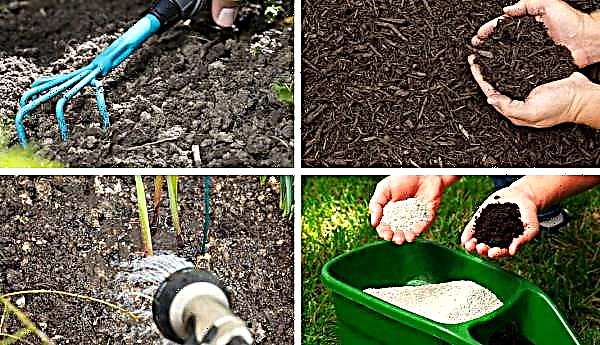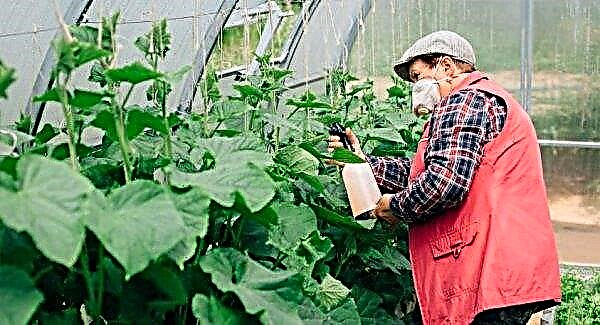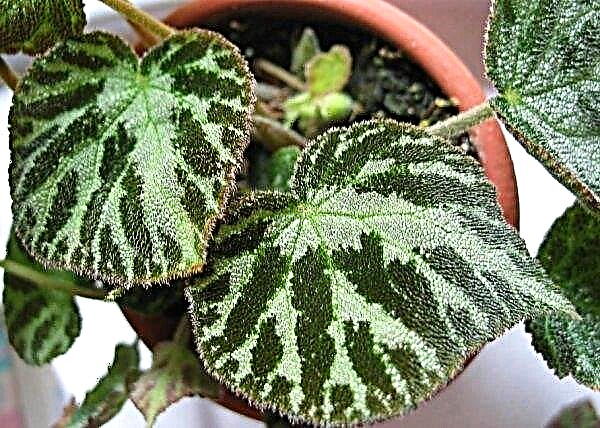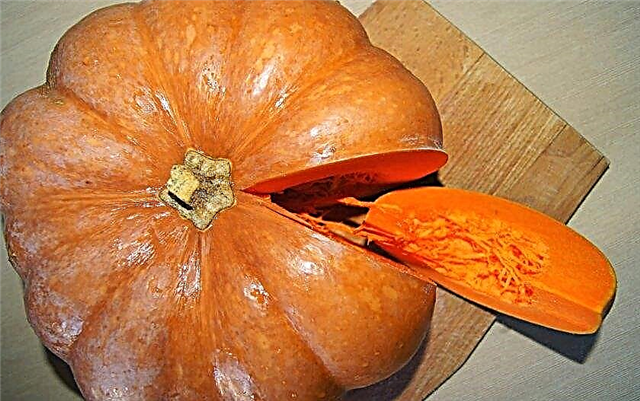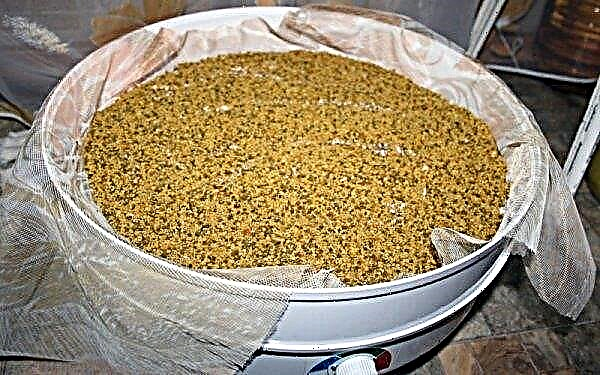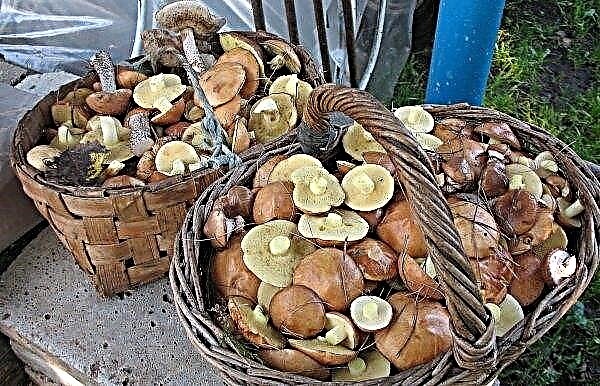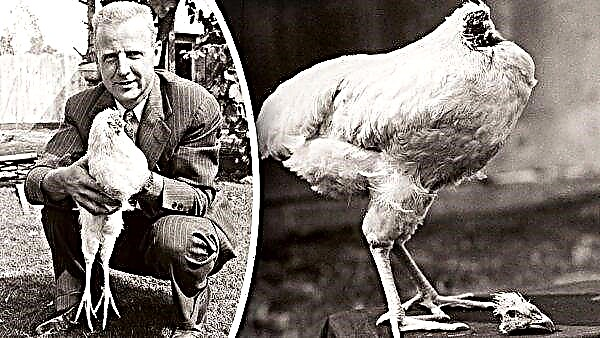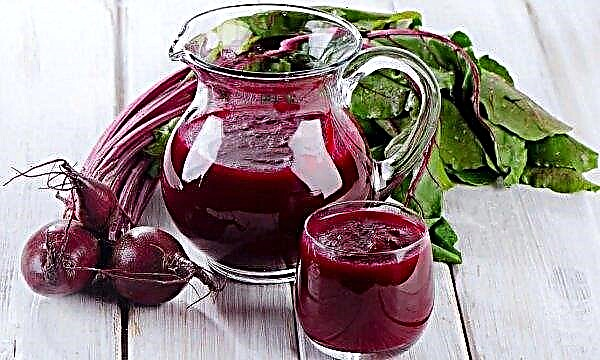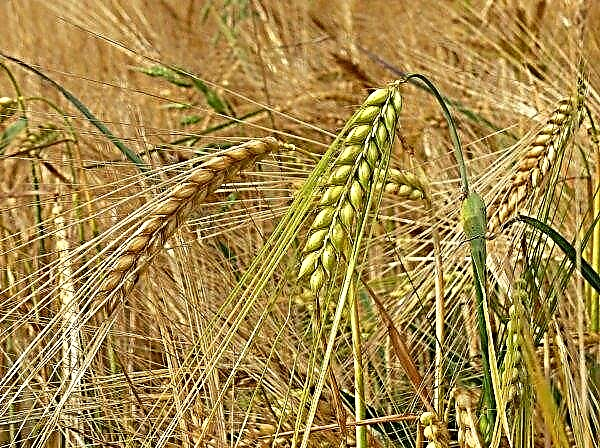Celery is a popular vegetable plant that many peoples actively use in cooking. It gives the dishes a spicy taste and has a number of beneficial effects on the human body. It is better to grow it in the spring seedling method. How to do this - read the article.
Plant description
Celery is a two-year-old plant that grows up to 1 m in height, having a thickened rhizome and cirrus dissected leaves. Blooms in white inflorescences. It belongs to the family of umbellate.
For culinary purposes, 3 types of celery are cultivated: root, petiole and leaf. The root vegetable gives a rounded root crop, reaching a diameter of 10 cm. In leaf - tender leaves are formed. Petiole leaves are large, petioles have white or pink hues.
 Root varieties of plants are not as popular as leafy
Root varieties of plants are not as popular as leafy
Celery has a pungent odor and a slightly bitter taste. It is used for the preparation of salads, first and second courses, seasonings, sauces, vitamin drinks. Seeds are used as seasoning.
Did you know? Residents of ancient Rome noticed that the leaves and roots of celery have a positive effect on the male and female reproductive systems. Centuries later, scientists proved this action of the plant, revealing in it the pheromone androsterone, which is secreted by the sweat glands of men to attract representatives of the opposite sex.
A vegetable plant has a rich chemical composition. It contains vitamins A, groups B, C, E, H, K, PP. It is rich in potassium, calcium, magnesium, sodium, phosphorus, iron, iodine, fluorine. In total, it consists of 8 macrocells and 17 microelements. It also has starch and sugars, saturated and polyunsaturated fatty acids.

The best varieties of celery
| The best among root varieties are: | Of the leaf most popular are: | Good characteristics are possessed by such varieties of petiole celery as: |
| Prague giant | Pep | Malachite |
| Diamond | Zahar | Gold |
| Albin | Sail | Pascal |
| Anita | Kartuli | Tango |
| Maxim | Gentle | Triumph |
Features of growing seedlings at home
Celery is a cold-resistant plant. In warm regions and the middle lane, it can be immediately sown on open beds. In the northern areas you need to apply the seedling method. By cultivating the plant with seedlings, you can achieve an earlier and better crop.
Video: Sowing seed celery root seedlings
Seed planting time
The optimal time for sowing seeds for growing seedlings is the end of February - the first of March. The beginning of the process should be calculated so that before the alleged planting in open ground or a greenhouse there are 60–70 days.
Selection of landing tanks and suitable soil
To grow seedlings, you will need to purchase high-quality seeds, prepare containers and soil substrate.
Seeds are better to buy in a specialized store. This ensures that you will definitely get the variety you want. Moreover, such seed does not require additional processing. You need to choose only fresh copies. These are the ones that can sprout quickly and amicably.

As containers for growing sprouts, wooden or plastic boxes, peat tablets, pots, and plastic cups are used.
The soil is also acquired in a specialized store. It should be light, loose and nutritious. If this is not possible, then you can prepare the soil substrate yourself from ingredients such as:
- peat (3 parts);
- vermiculite (1 part);
- humus (1 part).
Important! Soil prepared by yourself is subject to mandatory disinfection by soaking over steam, calcining in an oven or microwave, watering with a solution of potassium permanganate.
Seed treatment
Seeds harvested on their own or acquired “by hand” must be prepared for sowing. The preparation process is as follows:
- Wrap the seeds in gauze and dip them in water, heated to + 40 ... + 50 ° C for half an hour.
- To sustain in a growth stimulator, for example, "Epine", 2 hours.
- Disinfect the seeds by placing them in potassium permanganate (solution) for 45 minutes.
- Spread the seed on a damp cloth and place them in temperature conditions + 20 ... + 22 ° C for germination.
- The seeds are ready for sowing when they hatch.

Sowing seeds
During sowing, the seed must be evenly distributed on the surface layer of the soil substrate and lightly sprinkled with a thin layer of peat. Tanks must be placed in a room with a temperature regime of + 20 ° C.
If the seeds were previously germinated, then the first sprouts should appear after 5-7 days. Seeds that have not undergone preliminary preparation give seedlings after 10-15 days.

Further seedling care
After the seedlings appear, the temperature will need to be reduced to + 15 ° C. Seedlings should receive enough sunlight, so it must be grown in a bright place, or organize additional illumination. The room must be regularly ventilated to allow fresh air to flow.
Watering is first carried out from the spray gun, or through a fine sieve. If the seeds were sown in one container, then after the appearance of 2 leaves it is necessary to pick the plants in separate pots.
To sprouts were strong and healthy, they should be fed. The first fertilizer is produced 10-12 days after the pick. Apply nitrophosphate (1 tsp / 10 l of water). The flow rate of the working fluid is 2-3 tbsp. l for 1 pot. If the seedlings are too pale, then resort to feeding with urea. It is applied 2-3 times, withstanding intervals of 10-12 days.
 1-2 weeks before the planned movement of the sprouts into the ground, you need to start the hardening procedure - take them out to the street, daily increasing the time spent in the fresh air
1-2 weeks before the planned movement of the sprouts into the ground, you need to start the hardening procedure - take them out to the street, daily increasing the time spent in the fresh air
Landing
Before transplanting seedlings to open beds, you need to choose a suitable place and prepare it. It is important to adhere to the optimal timing and technology of landing.
Planting celery seedlings in open ground
Optimal timing
The best time for planting seedlings is the end of April - the beginning of May. There should be no frost at this time. The optimum air temperature for good growth is + 19 ... + 22 ° C. Sprouts should have a well-developed root system, 4-5 leaves and be 12-15 cm tall.
Important! Celery sprouts are not afraid of temperature drops to + 5 ° C. However, if values below + 10 ° C hold for a long time, this leads to the appearance of a peduncle in the first year and the development of poor-quality petioles and root crops.
Location selection and step-by-step transplantation scheme
Celery gives the best yields when cultivated on mineral-rich sandy, light and loose soils with a low or neutral pH. When selecting a place, you should stop at a well-lit and sheltered from drafts site.
To obtain a quality crop, prevent the development of diseases and the invasion of harmful insects crop rotation rules must be observed - plant celery in the beds where potatoes, cucumbers, cabbage, tomatoes, and legumes were previously grown. It is not necessary to place the described plant in the area after parsnip, dill, parsley, carrots.

In the autumn, beds should be prepared - digging to a depth of 25-30 cm and fertilizing: compost or humus (3.5-4 kg), double superphosphate (20 g / m²). In the spring, complex mineral fertilizer (35–40 g) is added to the ground.
As for the scheme of planting a vegetable crop at a constant place of growth, it looks like this:
- Furrows are made in the soil at a distance of 45-50 cm from each other.
- Sprouts are planted in them without destroying the earthen coma, observing a distance of 10 cm.
- After planting, the soil is moistened.

Features of further care
To care for celery does not need a lot of effort and time. Standard procedures will be required - regular watering, fertilizing, loosening, mulching, weeding, thinning.
Humidification of the soil is carried out once a week, spending 5 liters of water per 1 m². They are combined with loosening and mulching. The first procedure prevents the appearance of a hard crust and improves the moisture and air conductivity of the soil. The second - keeps moisture in the ground and inhibits the growth of weeds.
Did you know? In ancient times, celery was actively used as decorative elements. In the tomb of Tutankhamun, a shroud was found, decorated with garlands of various plants, including celery. And among the ancient Greeks it was customary to weave this plant culture into the wreaths with which the winners of sports were awarded.
Thinning is carried out as necessary. There should be a distance of 15–20 cm between adult plants of the leaf and petiole varieties of a vegetable; 30–40 cm should be left between bushes of plants of the root species.
Fertilizers are recommended to be applied twice during the growing season. The first time you need to fertilize the culture 14 days after moving the sprouts to a permanent place. The second - 20 days after the first. For leaf and petiole varieties, nitrogen- and potassium-containing mixtures are needed; for the root variety, potash mixtures are needed.

Thus, all types of celery are best grown through seedlings. With the observance of technology and proper agricultural technology, you can achieve friendly seedlings and an earlier, full-fledged crop.

